Killer Sudoku
Toroidal Killer Sudoku Pro
May 7th
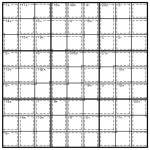
Toroidal Killer Sudoku Pro puzzle
Here’s something that I’ve actually never seen before – Killer Sudoku with toroidal cages. Perhaps there’s a good reason for that, but it’s time to find out. ![]() This is actually a Killer Sudoku Pro, so it doesn’t just involve addition – but you cannot repeat a number in a cage, unlike in CalcuDoku.
This is actually a Killer Sudoku Pro, so it doesn’t just involve addition – but you cannot repeat a number in a cage, unlike in CalcuDoku.
So the rules are:
- Place 1 to 9 into each row, column and bold-lined 3×3 box
- Place numbers in each cage to add/multiply/subtract/divide up to the total at the top-left of each cage
- Numbers may not repeat in a cage
- Some cages wrap around the edges of the puzzles, continuing directly opposite
This is rated ‘gentle’, and none of the toroidal cages are very large so shouldn’t be too confusing to follow (I hope!).
Good luck!
Killer CalcuDoku +/-
May 2nd
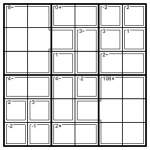
Killer CalcuDoku +/- 6×6 puzzle
There’s a lot of very interesting puzzle space to explore between the extremes of Killer Sudoku and KenKen (a trademark of Nextoy LLC, so I will always refer to this as CalcuDoku from now on, unless anyone suggests a better name!).
I’m going to define two in-between puzzles, giving a continuum like this:
- Killer Sudoku
- Killer Sudoku Pro – Killer Sudoku with extra operations (+, -, x, /)
- Killer CalcuDoku – Killer Sudoku Pro with repeated digits in cages, like CalcuDoku
- CalcuDoku – Killer CalcuDoku puzzles without box constraints (e.g. no 3×3 boxes)
To avoid confusion I’m going to draw Killer Sudoku and CalcuDoku the way they always are – with dashed-line cages in the first case and bold lines between squares for the latter (replacing the traditional Sudoku bold lines). Then to distinguish the others, Killer Sudoku Pro will appear exactly like Killer Sudoku except that there will be additional operators within the grid (for operator-less ones I’ll include a question mark “?” or similar after each clue). Killer CalcuDoku, meanwhile, will appear exactly like today’s puzzle – with solid cages within the main puzzle.
Now just to spice things up further, I’m going to mess around with how the puzzles work. Remember that the key difference between Sudoku and Killer Sudoku is that the digits now actually have value as well – so by fiddling with those values we can create an infinite range of new puzzles that solve in quite different ways.
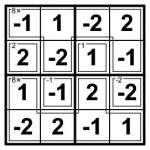
Example Killer CalcuDoku +/- solution
Today is a good example: here’s a 6×6 +/- Killer CalcuDoku. The aim is to place -3, -2, -1, 1, 2 and 3 into each row, column and 2×3 bold-lined box, and to place numbers so that the inner cages compute to the value given when applying the stated operation to the set of numbers in that cage. Subtraction and division are again defined as starting with the highest number in that cage (so remember that 2>-3!) and then applying all the other numbers in any order – so for example the solution to a “4-” cage could be “1 and -3″. Confused? See, I said it would mix things up! (1 – -3 = 4)
I’ve included an example (trivial) 4×4 Killer CalcuDoku +/- solution so you can be sure you understand how it works. But you might not need it – it’s actually a very gentle puzzle I’ve attached, as you’ll probably soon find out… (well, once you get your head around the negative numbers!)
Good luck!
Killer Sudoku Pro / All Signs
May 1st
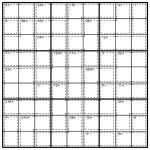
Killer Sudoku All Signs puzzle
Here’s a Killer Sudoku with “all the signs”, or Killer Sudoku Pro if you prefer. If you’ve got any ideas for a better name let me know! ![]()
As in a regular Killer puzzle, you can’t repeat a digit within the solution to any cage. Unlike in a regular Killer, all non-single cages specify the operation that is applied to produce the result given. If the operation is + or x then just add or multiply all the digits to give that total. For subtraction and division you must start with the largest number in the region and subtract or divide the other numbers from that to give the stated result (this is what you’d do intuitively, I think, but since these operations aren’t commutative it’s necessary to state this!) Other than that, regular Sudoku rules apply: place 1 to 9 into each row, column and bold-lined 3×3 box.
The logic is once again simple, as a first example of this puzzle type, but I think the wider range of operations brings a freshness to the puzzle. Let me know if you agree (or disagree!).
Good luck!
Killer Sudoku Multiplication
Apr 30th
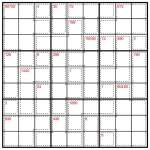
Killer Sudoku Multiplication 9×9 puzzle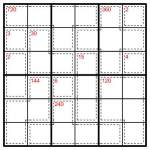
Killer Sudoku Multiplication 6×6 puzzle
I thought it would be interesting to see what a Killer Sudoku puzzle would look like if every operation in it was multiplication, so I decided to try it out.
The puzzles attached aren’t labelled with ‘x’ signs, but it should be fairly obvious from the totals that addition is not enough! Single-cell regions are simply equal to the stated value, but in all others you must multiply all of the cell values together to give the total at the top-left. Note that this follows Killer Sudoku rules, so a number cannot be repeated within a region.
These are all definitely rated ‘gentle’ – the logic required is simple, even though the multiplication might appear intimidating! In actual fact you don’t need to calculate most of the big values – try the 6×6 puzzle first to see why this is.
Good luck!
PS Subtraction and division are less interesting, unless you allow negative or fractional numbers! I’ll probably post examples of both the next couple of days anyway however!
Samurai Star Killer Sudoku
Apr 29th
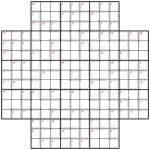
Samurai Star Killer (gentle) puzzle
“Star Killer” sounds like something out of science fiction, but it’s now definitely reality with this 5-grid Killer Sudoku puzzle. The actual Killer part uses the most basic logic imaginable, and there are a lot of ’singleton’ regions which I’ve never used in a Killer puzzle before. The reason for this is that I wanted to start at a gentle level – as a result this mostly solves like a regular Samurai Star (a.k.a. Flower Samurai) puzzle, with the Killer regions used occasionally to either get you going or help you out with a quick number along the way. It shouldn’t take you much over 20 or 30 minutes if you’ve solved this shape of Samurai before, and know what a Killer Sudoku is!
The rules are pretty simple: place 1 to 9 into each row, column and bold-lined 3×3 shape of each of the 5 underlying 9×9 grids (there’s one in the centre too), whilst also placing numbers so that the total in each dashed-line cage is equal to that given in the top-left corner. You may not repeat a number within a dashed-line cage.
The puzzle has rotation symmetry order 4, so the cages are in a pleasing pattern I hope – I particularly like the hole in the square in the centre! I think by and large that if you can create the cages or givens in a puzzle with the same order of symmetry that you have for the grid layout itself that this generally leads to a more pleasing appearance for the puzzle; but more than this, I find that this tends to follow through with the solving process, and you end up with pieces of the puzzle that feel ’sympathetic’ to one another, since the symmetry leads to related discoveries. However it’s perhaps not clear that this solving benefit carries through to a puzzle this large, and it’s probably the case that a puzzle with entirely random cages would feel just the same to actually solve at this size. But it wouldn’t look as nice!
Coming up in the following days I’m going to experiment in the space between Killer Sudoku and Ken Ken™ – in other words, using more operations than just addition, and possibly allowing repeated numbers in cages (although not on puzzles with 1-9 to place!). I already came across a puzzle called ‘Killer Sudoku Pro’ in the Saturday Telegraph newspaper (UK) – in this they keep the Killer Sudoku rules about not repeating digits in a cage, but specify different operations for cages (in actual fact the rules aren’t stated next to the puzzle in full, but I presume repeated digits are disallowed - it certainly solves okay with that assumption!). I haven’t seen anything precisely like that elsewhere and I thought it was actually quite fun (it wasn’t too hard!) so I’ll definitely try making some of those soon for sure. If you have any other ideas for how to mix these different types together feel free to post a comment!
Good luck!

Recent Comments